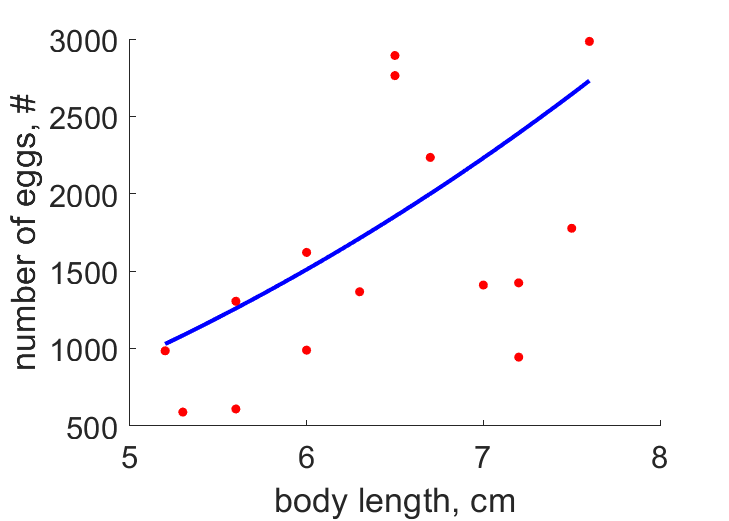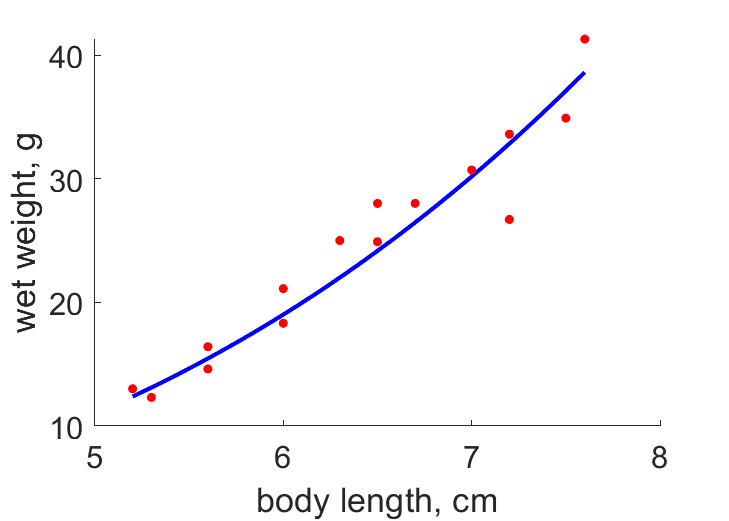Predictions & Data for this entry
| Model: std | climate: Cfb, Dfb | migrate: | phylum: |
| COMPLETE = 2.5 | ecozone: THp | food: bjO, jiCi | class: |
| MRE = 0.162 | habitat: 0jFp, jiTf, jiTi | gender: Dg | order: |
| SMSE = 0.045 | embryo: Fpf | reprod: O | family: |
Zero-variate data
| Data | Observed | Predicted | (RE) | Unit | Description | Reference |
|---|---|---|---|---|---|---|
| ab | 8 | 8.339 | (0.04233) | d | age at birth | Gunt1990 |
| tj | 120 | 193.5 | (0.6124) | d | time since birth at metam | Gunt1990 |
| tp | 730 | 548.3 | (0.2489) | d | time since metam at puberty for females | SochOgie2010 |
| am | 2190 | 2190 | (9.529e-06) | d | life span | AnAge |
| Lb | 0.89 | 1.143 | (0.2839) | cm | total length at birth | Gunt1990 |
| Ljb | 6.5 | 5.063 | (0.221) | cm | total length of tadpole at metam | Gunt1990 |
| Lj | 1.9 | 1.852 | (0.02546) | cm | SVL of frog at metam | Gunt1990 |
| Lp | 3.9 | 4.555 | (0.1681) | cm | total length at puberty | Gunt1990 |
| Li | 7.6 | 7.684 | (0.01102) | cm | ultimate total length | Gunt1990 |
| Wwb | 0.0063 | 0.006419 | (0.01892) | g | wet weight at birth | Gunt1990 |
| Wwj | 0.65 | 0.5585 | (0.1408) | g | wet weight at metam | Gunt1990 |
| Wwp | 7 | 8.316 | (0.188) | g | wet weight at puberty | Gunt1990 |
| Wwi | 41.3 | 39.91 | (0.03373) | g | ultimate wet weight | Gunt1990 |
Uni- and bivariate data
| Data | Figure | Independent variable | Dependent variable | (RE) | Reference |
|---|---|---|---|---|---|
| LN |  | body length | number of eggs | (0.3664) | Gunt1990 |
| LW |  | body length | wet weight | (0.07451) | Gunt1990 |
Pseudo-data at Tref = 20°C
| Data | Generalised animal | Pelophylax lessonae | Unit | Description |
|---|---|---|---|---|
| v | 0.02 | 0.08606 | cm/d | energy conductance |
| kap | 0.8 | 0.5686 | - | allocation fraction to soma |
| kap_R | 0.95 | 0.95 | - | reproduction efficiency |
| p_M | 18 | 49.42 | J/d.cm^3 | vol-spec som maint |
| k_J | 0.002 | 0.002 | 1/d | maturity maint rate coefficient |
| kap_G | 0.8 | 0.8018 | - | growth efficiency |
Discussion
- tadpoles are assumed to differ from frogs by del_M only
- males are assumed to not differ from females
Facts
- The fertile hybrid of P. ridibundus and P. lessonae is called P. esculentus (Ref: Wiki)
Bibliography